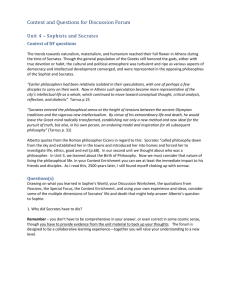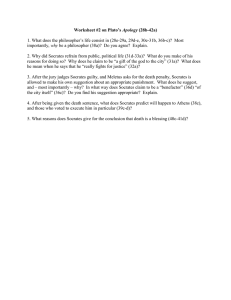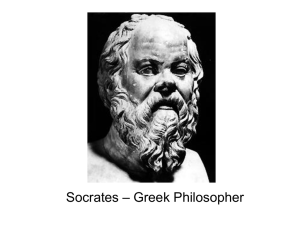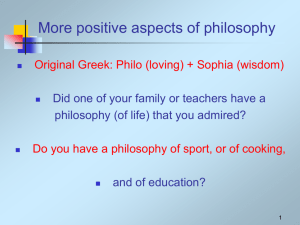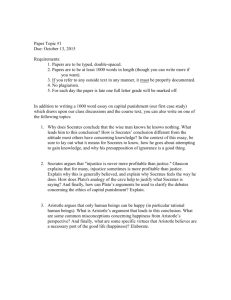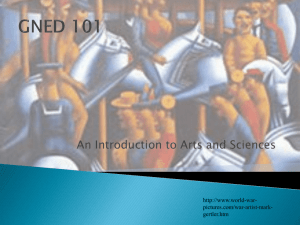426 BLAISE BLAIN AND STAFF
advertisement
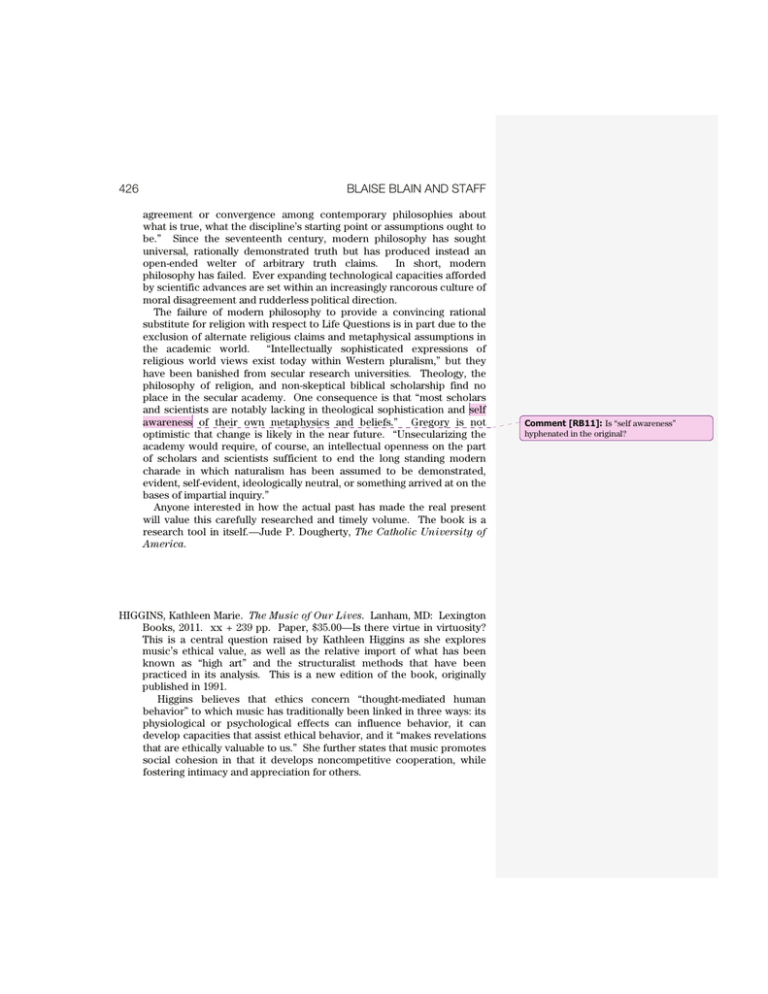
426 BLAISE BLAIN AND STAFF agreement or convergence among contemporary philosophies about what is true, what the discipline’s starting point or assumptions ought to be.” Since the seventeenth century, modern philosophy has sought universal, rationally demonstrated truth but has produced instead an open-ended welter of arbitrary truth claims. In short, modern philosophy has failed. Ever expanding technological capacities afforded by scientific advances are set within an increasingly rancorous culture of moral disagreement and rudderless political direction. The failure of modern philosophy to provide a convincing rational substitute for religion with respect to Life Questions is in part due to the exclusion of alternate religious claims and metaphysical assumptions in the academic world. “Intellectually sophisticated expressions of religious world views exist today within Western pluralism,” but they have been banished from secular research universities. Theology, the philosophy of religion, and non-skeptical biblical scholarship find no place in the secular academy. One consequence is that “most scholars and scientists are notably lacking in theological sophistication and self awareness of their own metaphysics and beliefs.” Gregory is not optimistic that change is likely in the near future. “Unsecularizing the academy would require, of course, an intellectual openness on the part of scholars and scientists sufficient to end the long standing modern charade in which naturalism has been assumed to be demonstrated, evident, self-evident, ideologically neutral, or something arrived at on the bases of impartial inquiry.” Anyone interested in how the actual past has made the real present will value this carefully researched and timely volume. The book is a research tool in itself.—Jude P. Dougherty, The Catholic University of America. HIGGINS, Kathleen Marie. The Music of Our Lives. Lanham, MD: Lexington Books, 2011. xx + 239 pp. Paper, $35.00—Is there virtue in virtuosity? This is a central question raised by Kathleen Higgins as she explores music’s ethical value, as well as the relative import of what has been known as “high art” and the structuralist methods that have been practiced in its analysis. This is a new edition of the book, originally published in 1991. Higgins believes that ethics concern “thought-mediated human behavior” to which music has traditionally been linked in three ways: its physiological or psychological effects can influence behavior, it can develop capacities that assist ethical behavior, and it “makes revelations that are ethically valuable to us.” She further states that music promotes social cohesion in that it develops noncompetitive cooperation, while fostering intimacy and appreciation for others. ȱ &RPPHQW>5%@Is “self awareness” hyphenated in the original? SUMMARIES AND COMMENTS 427 One means by which this is achieved, she avers, is by modeling desirable social interaction. She taps sources as diverse as Plato, Augustine, Kant, Langer, Meyer, Kivy, and Zuckerkandl, and asserts that musical patterns of tension and resolution can mirror successful resolutions in life. Further, in genres such as jazz (and the solo concerto), single voices can be pitted against a mass of sound, from which we can infer interactions writ small between the individual and society, or even between races. But if music can inspire lofty thoughts and behaviors, it must also have the power to effect antisocial behavior, as Higgins notes in a section “Unethical Music.” Here, she remarks that music may incite “Dionysian” passions and lower inhibitions. Hence the recurring urge to ban some music, from ancient Greece to the threats in our own time to censor rock music. These are complex issues that, to be explored in detail, would require a study of much greater breadth than this book allows. Just the questions raised in comparing the effects of text-related and instrumental pieces are innumerable, and identifying musical “tensions” in both Indian raga and atonal artmusik requires subtle analytical tools. What Higgins specifies clearly, however, is the enemy: the structuralist approach to musical form epitomized by Hanslick. She writes: “a narrow, structurally based formalism has been largely responsible for the disappearance of the ethical dimension from philosophical accounts of music.” She argues that when music is “defined as ‘a musical score’ and aesthetics becomes a technical enterprise,” essential elements of the musical experience are screened out, with a concomitant loss of ethical involvement. But to whom does Higgins address her arguments? Would a Balinese gamelan player care about what Hanslick, or his intellectual heirs in the Western academy, write? Higgins is, in fact, arguing for Western academic acceptance of non-Western music, for studying musical events within their social contexts, and for the inclusion of performance-related issues. Regarding the last, she writes, “The emphasis on music as heard marks a rebellion—I would like to think a populist rebellion—against the dominant view in nineteenth- and twentieth-century Western musical aesthetics, which treats performance as inessential to what music is.” In the intervening years since the original publication of her book, however, these wishes have been largely granted, the coup d’état successful. World music is now a required topic at all accredited schools, performance studies are common, and structuralist theories are routinely attacked. As ethnomusicologist Kay Kaufman Shelemay writes in the current issue of the Journal of the American Musicological Society: “The music subdisciplines have to a certain extent converged in recent decades, with music historians moving emphatically into collective cultural domains.” Music theorists have also acknowledged social context, as recent studies of the history of music theory attest. Similarly, Higgins’s call for the recognition of the physiological bases of ȱ ȱ 428 BLAISE BLAIN AND STAFF musical experience as a source of music’s powers has been answered by neurological explorations in such fields as that of mirror neurons. Higgins does not, however, completely dismiss the study of form: she writes, “formal features of music can be seen as analogous to patterns observable in ethical experience.” Nor does she deride the idea of organic unity, a concept inextricably linked to the “formalist” theories, not just of Hanslick (whose diatribes were a reaction against his own era), but of Schoenberg and Schenker: “From my point of view, the metaphor of the biological organism . . . invites comparison with other kinds of harmony.” By embracing these means of understanding music within her purview, Higgins shows an intellectual generosity no longer commonplace. The last twenty-odd years have seen battle lines drawn much more sharply. Her inclusion of all aspects of musical thought is as rare today as it is welcome. But her book should now be read, as the author herself would no doubt wish, as a product of an earlier, less strident time.—Deborah Burton, Boston University. HOWLAND, Jacob. Kierkegaard and Socrates: A Study in Philosophy and Faith. Cambridge and New York: Cambridge University Press, 2006. xii + 231 pp. Cloth, $80—Kierkegaard and Socrates consists of ten chapters plus an epilogue. The book is not a comprehensive treatment of Kierkegaard's view of Socrates; it does not, for example, deal with Kierkegaard's doctoral dissertation, The Concept of Irony with Continual Reference to Socrates. Rather, as Howland's subtitle indicates, this book is primarily a study of Kierkegaard's treatment of Socrates in just one book, Philosophical Fragments. At least that is true for chapters 2-9, though an interpretation of Plato's Apology is also given. Chapter 1 is an examination of an early, fragmentary, and unpublished manuscript of Kierkegaard's, Johannes Climacus, and Chapter 10 gives an account of some of what is said about Socrates (and about Philosophical Fragments) in Concluding Unscientific Postscript. The "Epilogue" looks at Kierkegaard's view of Socrates mainly as expressed in a few late journal entries. The main thesis of Kierkegaard and Socrates is that the common reading of Philosophical Fragments as developing a sharp either/or between "Socratic philosophizing" and Christian faith is misleading. Rather, the figure of Socrates as it is developed in Fragments is shown to have significant similarities to that of Christ. Howland gives a somewhat novel interpretation of the Socrates of Fragments that emphasizes the way philosophy itself, for Socrates, is rooted in the passion of eros, a passion that makes it possible for the philosopher to have a kind of “prophetic” intimation of “the god.” Thus Socrates is not merely a figure who withdraws from temporality to eternity in “recollection” but one who has a kind of relation to the god in his own ȱ
